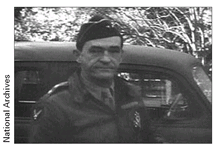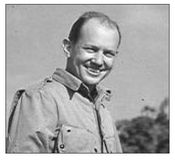War Stories II (27 page)
Authors: Oliver L. North

By 23 August, when the Japanese began large-scale bombing raids on Nanking, Chennault had two partially trained Chinese fighter squadrons and an air group made up of Russian expatriates. Flying outmoded Curtiss Hawks and old Boeing P-26s, they scored well against the unescorted land-based bombers that the Japanese launched from Formosa. But when the Japanese responded by sending fighter escorts with the bombers, the scales again tipped against the young Chinese pilots.
Despite Chennault's best effortsâand those of his expatriate pilots, mechanics, and techniciansâthere was a limited amount that could be done without modern aircraft. In a letter handwritten by Madame Chiang and signed by the Generalissimo, they made an emotional appeal directly to President Roosevelt, begging for aid.
On 7 October, without reference to the letter, Roosevelt announced that he would not invoke the new Neutrality Act against China. But he didn't
promise aid either. Instead he “condemned” the Japanese invasion and called for an international conference in Geneva to discuss “the deteriorating situation in China.”
promise aid either. Instead he “condemned” the Japanese invasion and called for an international conference in Geneva to discuss “the deteriorating situation in China.”
The Generalissimo, Madame Chiang, and Chennault now realized that whatever help the Chinese air force might get from the United States wasn't going to come soon. And they were right. When the Japanese finally broke through Chinese lines and invaded Nanking, the Nationalist capital, in mid-December, the Chinese air force had fewer than fifty planes left. As the invaders commenced an orgy of rape, murder, and plunder in Nanking, Chennault was trying to reconstitute a fighting force in Hankow, 300 miles farther up the Yangtze.
Â
Claire Chennault

Photographs and films of the “Rape of Nanking” stunned the civilized world. Now Madame Chiang's correspondence to her friends in the Statesâand countless other letters from missionaries to congregations across Americaâcontained graphic images showing and describing stacks of dead Chinese women and children; Chinese men being shot, bayoneted, disemboweled, and beheaded; and countless other Japanese atrocities. It was genocide on an enormous, very visible scale, and yet the rest of the world looked on and officially did nothing to intervene.
But “unofficially,” Roosevelt did intervene. In January 1938, the White House very quietly authorized American companies to start selling used or outdated aircraft, arms, and military equipment to the Nationalist government by transacting the sales through entities like the Universal Trading Corporation, the Central Aircraft Manufacturing Company (known as CAMCO) and the China National Aviation Corporation. But the trickle of planes, parts, and aviation support equipment that started to arrive in China during the spring of 1938 wasn't enough to slow the Japanese advance. By August, the capital had to be moved againâthis time well into the Chinese interior, to Chungking. Chennault packed up and moved the
Chinese Air Force Training Command to Kunming, in western Yunnan Province, practically in the foothills of the Himalayas.
Chinese Air Force Training Command to Kunming, in western Yunnan Province, practically in the foothills of the Himalayas.
Ensconced on the sprawling base at Kunming, Chennault spent the balance of 1938 and nearly the whole of 1939 and 1940 doing what he did best: teaching others how to fly and fight. When the lack of planes, parts, or pilots grounded his students, he used the time to construct outlying airfields. He also built an early warning network to warn of Japanese air raids and a primitive but effective radio and telegraph communications system linking the Chinese air bases. Chennault also devised plans for recovering downed aviators and returning them to safety. During this period he wrote home frequently, commenting to friends and family about the courage of the Chinese soldiers, the bravery of the Chinese people, and the daring of his Chinese pilotsâand reminded them of the one thing that was most needed: decent planes to take on the Japanese.
By the summer of 1940, the Chinese had given up more than half a million square miles of territory and nearly 200 million people to Japanese domination. Americans reading about the plight of the Chinese in their church bulletins didn't hesitate to remind their congressmen that this was an election year. In September 1940, Congress approved a loan of $25 million to the Chinese government for “economic support.” But it was too little, too late. It was clear to the Generalissimo, Madame Chiang, and Chennault that courage was no longer enough. Unless the Chinese got some modern arms and aircraftâand quicklyâthe Japanese were going to succeed in conquering
all
of China. Chiang decided that Chennault should return to the United States and make a personal effort to get planes andâif possibleâpilots.
all
of China. Chiang decided that Chennault should return to the United States and make a personal effort to get planes andâif possibleâpilots.
Chennault arrived in Washington on 1 November, on the eve of the presidential election. There, Chennault drew up a wish list of all that the Chinese air force needed in order to fight the Japanese. At the top of the long list of planes, parts, ammunition, and the machinery of war, he wrote: “Time.”
The only way to buy time for the Chinese pilots, aircrews, mechanics, and repair personnel would be to have someone else do the fighting for
them. So Chennault prepared a separate list: “350 pursuit aircraft; 150 bombers; Americans to fly them.”
them. So Chennault prepared a separate list: “350 pursuit aircraft; 150 bombers; Americans to fly them.”
The November election made it clear that the American people wanted to avoid war if possible, but that they also wanted to support the Chinese. In December, FDR got another $100 million loan for Chiang. Chennault promptly arranged for the purchase of a hundred Curtiss-Wright P-40C fighters.
Once he had decided that the P-40 was what they needed, Chennault wanted to make sure that the Chinese supported his decision. A group of visiting Chinese officials gave him that opportunity. Chennault took them to nearby Bolling Field, just across the Anacostia River from the Capitol, to demonstrate the Curtiss P-40. When the flight demonstration was over, the Chinese were considerably excited. One of them told Channault, “We need a hundred of those airplanes!”
Chennault shook his head. “No,” he said, tapping the chest of one of his pilots, “you need a hundred of these.”
The aviator who piloted the P-40 for Chennault and the Chinese officials that day was a young Army Air Corps first lieutenant named John Alison.

FIRST LIEUTENANT JOHN ALISON, USAAF
Bolling Air Force Base
Washington, D.C.
December 1940
Bolling Air Force Base
Washington, D.C.
December 1940

I reported to the commander's office, where Claire Chennault, several Chinese, and two representatives from the Curtiss-Wright Company had already arrived. The commander said, “We want you to demonstrate the airplane for the Chinese.”
The Curtiss salesman had one of their test pilots there. He said, “Can our pilot fly the airplane?” Well, the commander at Bolling didn't want to do that. And finally, the salesman just threw up his hands and says, “Well, go on out and use your judgment to demonstrate the airplane.”
I knew the airplane very well by this time; I lined the airplane up right into the wind. The Chinese all went out to the middle of the field. And I put the throttle up to 980 horsepower and ran down the runway. Just as soon as I got it off the ground, I started the wheels up, pushed it up to full throttle, and let it go.
Now, this airplane wasn't one that was ready for combat. It had no bulletproof fuel tanks, guns, or armor plate. And it didn't have tactical radios, so it was a very light aircraft, and it just
soared
skyward. I did a loop right off the runway. And then I came down at low altitude, below a hundred feet, and put the tip of the wing right over the group, made a number of circles at max power, did a chandelle, and landed.
soared
skyward. I did a loop right off the runway. And then I came down at low altitude, below a hundred feet, and put the tip of the wing right over the group, made a number of circles at max power, did a chandelle, and landed.
When I got into the hangar, I could tell by the smile on the face of the Curtiss salesman that he liked the demonstration. And the Chinese were excited.
After that, Chennault went back to China. Little did I know that I'd be flying for him later in the war.
 KUNMING AIR BASE
KUNMING AIR BASE1 ST AIR COMMANDOS
SOUTHWESTERN CHINA
11 MAY 1942
SOUTHWESTERN CHINA
11 MAY 1942
Now that he had the planes the Chinese needed, Chennault set to work making arrangements to have them packed and shipped. He was about to gain an unlikely ally in his quest for American pilots to fly them.
Navy Commander Edward O. McDonnell was a member of a military assessment team dispatched to China by the White House. Shortly after the new year began, McDonnell returned with the recommendation that an American Volunteer Group (AVG) of aviators be immediately formed and dispatched to help the Chinese. McDonnell urged that the AVG be formed from officers and enlisted aviators “recently retired' or “loaned” from the Army, Navy, and Marine Corpsâand that they be allowed to “return to their service” in the event of war. To head the AVG, McDonnell suggested
“an experienced American aviation officer accountable only to Chiang Kai-shek⦠Chennault is the best available officer.”
“an experienced American aviation officer accountable only to Chiang Kai-shek⦠Chennault is the best available officer.”
Roosevelt agreed, and the AVG officially came into existence on 15 April 1941. Chennault plunged into his new assignment, dispatching recruiters to Army, Navy, and Marine air bases to find volunteers. He charged around Washington and New York with characteristic bravado, calling on friends and contacts, trying to find a ship to carry his newly acquired aircraft and personnel to China via Burma.
In total, 112 American military pilots “resigned” from their U.S. military units with the understanding from their president that they could return to their respective branches of service when their job was done.
In July 1941, the first of the AVG planes and personnel finally arrived in Rangoon. But to Chennault's frustration, it would take nearly five more months to unpack the planes, assemble and test them, and whip his volunteer pilots into effective fighter pilots who could fly and fight as a team.
The first AVG planes and pilots didn't get over “the hump” to China until 18 Decemberâten days after Pearl Harbor was attacked. Two of the three AVG squadrons saw their first action two days later, when the early warning network Chennault had installed two years earlier alerted them to an incoming raid by ten Japanese aircraft. For months, while Chennault was away in the United States, the Japanese had been sending their twin-engine Mitsubishi bombers over Kunming virtually unopposed.
Other books
The Most Evil Secret Societies in History by Shelley Klein
Herald of the Storm by Richard Ford
Morning Sky by Judith Miller
Sunburn (Book 1, The Events Trilogy) by Gorvine, Samuel
A Catered Tea Party by Isis Crawford
Color Me Bad: A Novella by Sala, Sharon
The Madness of Gods and Kings by Christian Warren Freed
The Man in the Tree by Damon Knight
Reinventing Jane Porter by Dominique Adair
Feral Heat: Shifters Unbound Novella by Ashley, Jennifer
